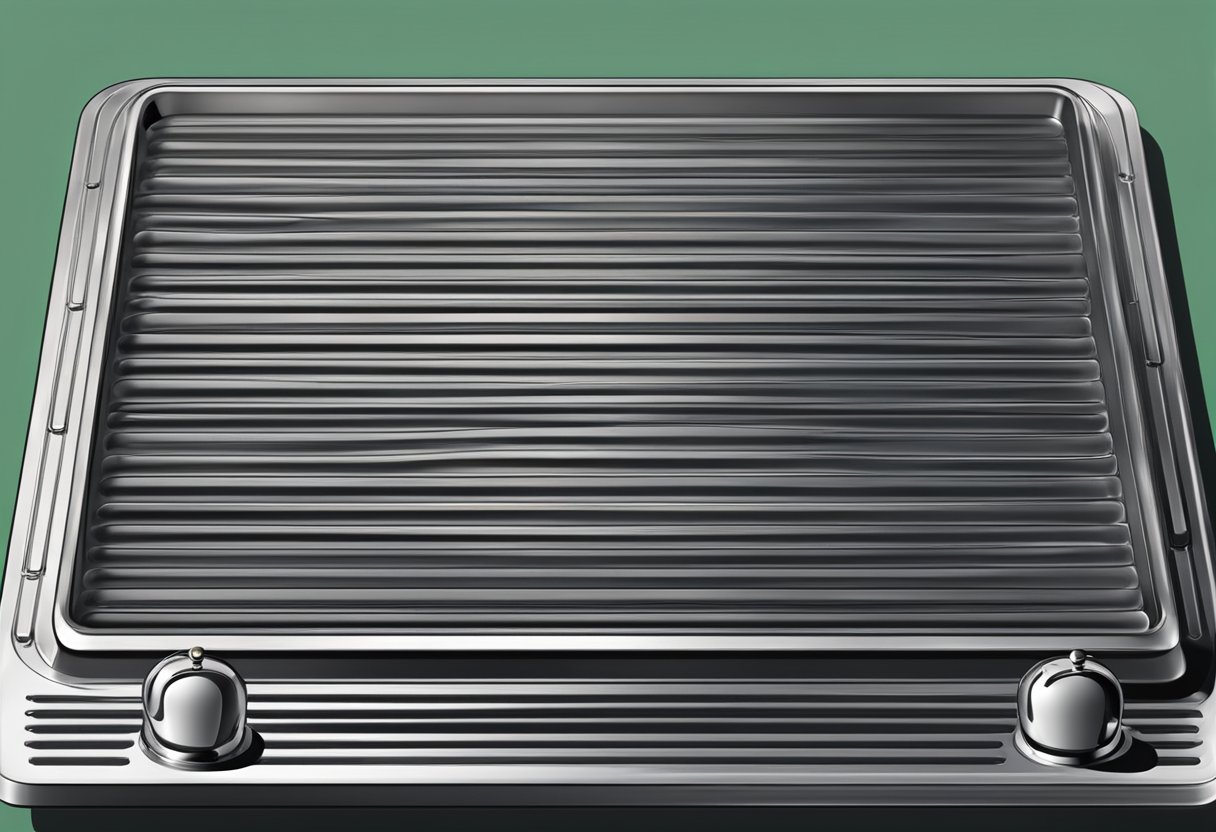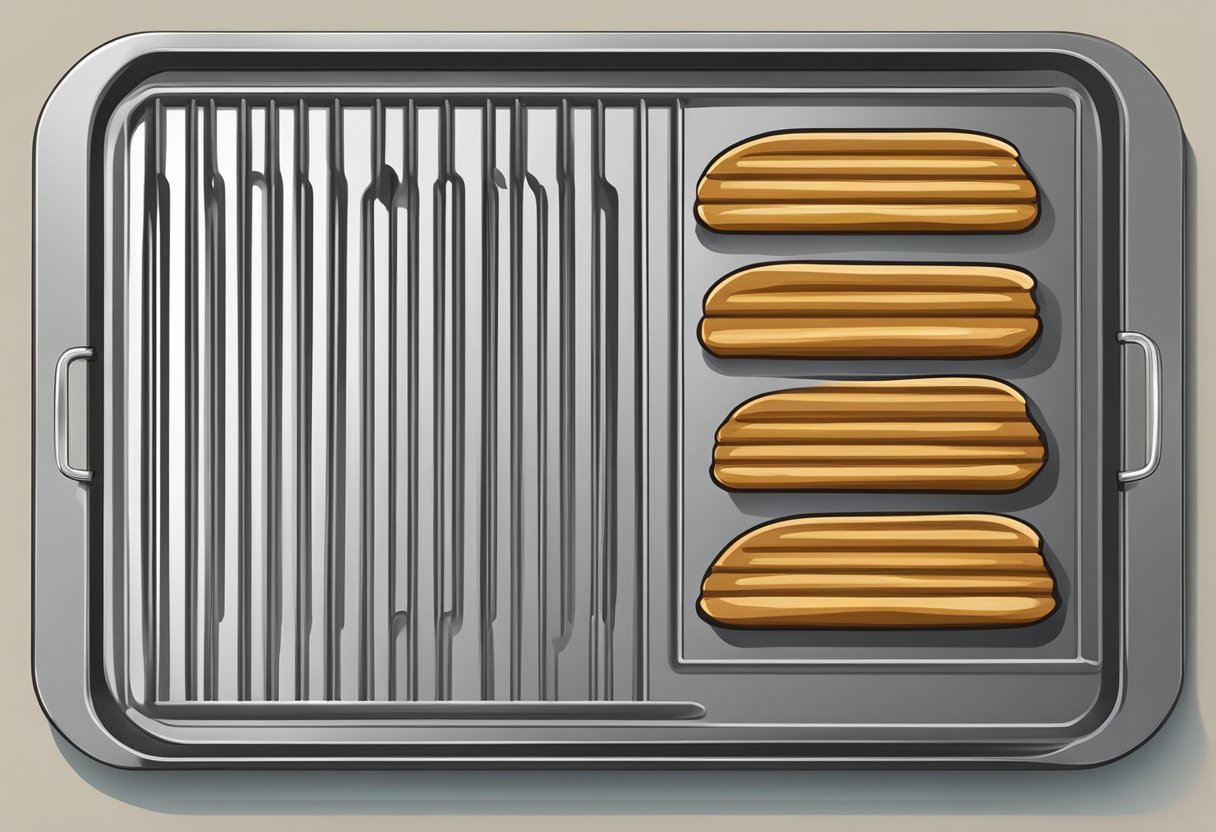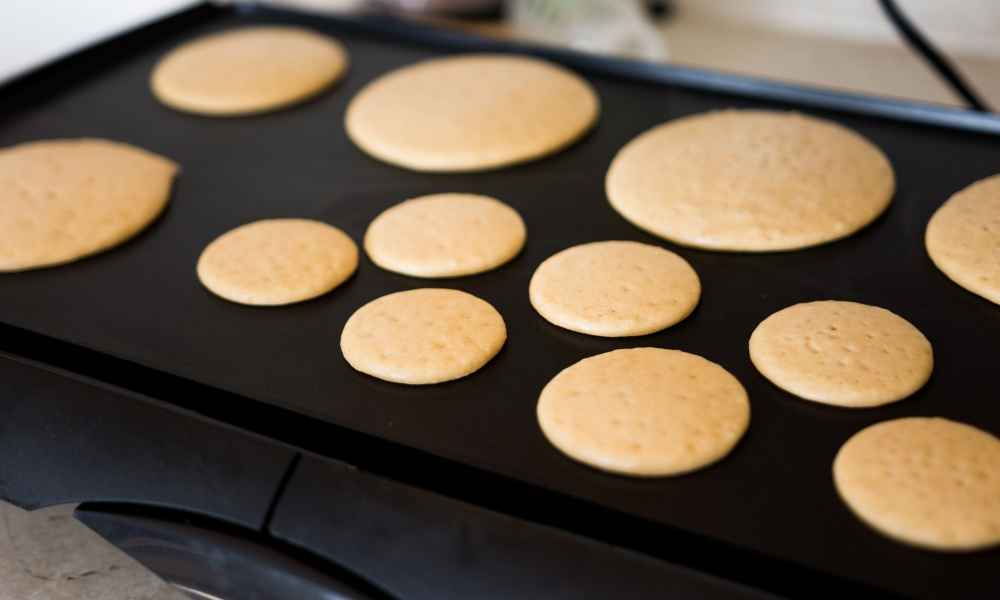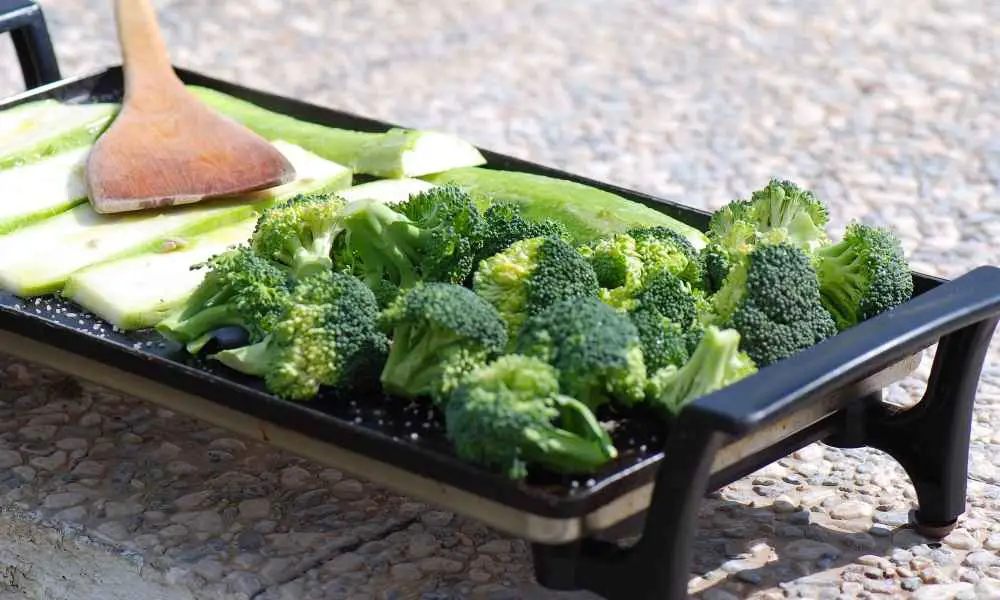Are you tired of using a regular flat griddle for cooking? Do you want to add some texture and flavor to your meals? Then you might want to consider using a griddle with ridges. These types of griddles are perfect for cooking meats, vegetables, and even sandwiches, as they create grill marks and allow excess fat to drip away from the food.

A ridged griddle is typically made of cast iron, which is a durable and heat-resistant material that retains heat well. The ridges on the griddle create a seared effect on the food, which adds flavor and texture. You can use a ridged griddle to cook steaks, burgers, chicken, fish, and even vegetables like asparagus and zucchini. The ridges also help to drain excess fat away from the food, making it a healthier option compared to frying or sautéing.
If you’re new to using a ridged griddle, there are a few things to keep in mind. First, make sure to preheat the griddle before cooking to ensure even heat distribution. You can also lightly oil the ridges to prevent sticking, although the ridges themselves will create some natural non-stick properties once they are properly heated. With a little practice, you’ll be able to create delicious and visually appealing meals with your ridged griddle.
Understanding Griddles with Ridges

What are Griddles with Ridges
Griddles with ridges are a type of cookware that have raised ridges or grooves on the cooking surface. These ridges are designed to create grill marks on the food being cooked and to allow excess fat to drain away from the food. They are commonly made from materials such as cast iron, aluminum, or stainless steel and are available in various sizes and shapes.
Importance of Ridges
The ridges on a griddle serve several important purposes. First, they create those attractive grill marks on the food, which not only look great but also add a smoky flavor to the food. Second, the ridges help to prevent the food from sticking to the cooking surface, which can be a common problem when cooking on a flat griddle. Third, the ridges allow excess fat to drain away from the food, making it healthier to eat.
When cooking on a griddle with ridges, it’s important to preheat the griddle before adding any food. This will help to ensure that the food cooks evenly and that the ridges create those desirable grill marks. It’s also important to use the right type of cooking oil, such as vegetable oil or olive oil, to prevent the food from sticking to the ridges.
Overall, griddles with ridges are a versatile and useful tool for any kitchen. They can be used to cook a wide variety of foods, from vegetables to meats and even pancakes and eggs. So, whether you’re a professional chef or a home cook, consider adding a griddle with ridges to your collection of cookware.
Types of Griddles with Ridges

When it comes to griddles with ridges, there are a few different types to consider. Each type has its own unique features and benefits that make it a great choice for cooking a variety of foods.
Cast Iron Griddles
Cast iron griddles are a popular choice for those who want a durable and versatile cooking surface. These griddles are made from heavy-duty cast iron, which allows them to retain heat evenly and cook food to perfection. Cast iron griddles with ridges are great for cooking meats, as the ridges create those classic grill marks that everyone loves.
One of the benefits of cast iron griddles is that they can be used on a variety of heat sources, including gas stoves, electric stoves, and even outdoor grills. They are also easy to clean and maintain, as long as you follow the manufacturer’s instructions.
Non-Stick Griddles
Non-stick griddles are another popular choice for those who want an easy-to-clean cooking surface. These griddles are typically made from aluminum or another lightweight material, and they have a non-stick coating that prevents food from sticking.
Non-stick griddles with ridges are great for cooking a variety of foods, including pancakes, eggs, and grilled sandwiches. They are also easy to clean, as you can simply wipe them down with a damp cloth or sponge.
Electric Griddles
Electric griddles are a convenient choice for those who want to cook without using a stove. These griddles plug into an electrical outlet, and they heat up quickly and evenly. Electric griddles with ridges are great for cooking a variety of foods, including burgers, steaks, and vegetables.
One of the benefits of electric griddles is that they are easy to use and clean. Many models are dishwasher safe, which makes cleaning up a breeze. They are also great for those who live in apartments or other small spaces, as they don’t take up much room and can be stored easily.
Overall, there are many different types of griddles with ridges to choose from. Whether you prefer cast iron, non-stick, or electric, there is a griddle out there that will meet your needs and help you cook delicious meals.
Choosing the Right Griddle

When it comes to choosing the right griddle with ridges, there are a few factors to consider. The size and shape of the griddle, as well as the depth of the ridges, can greatly affect your cooking experience.
Size and Shape
The size and shape of your griddle will depend on your personal preferences and cooking needs. Consider the following factors when choosing the size and shape of your griddle:
- Cooking surface area: Do you need a larger surface area to cook for a group of people or a smaller surface area for personal use?
- Storage space: Do you have enough storage space for a larger griddle or do you need a smaller, more compact option?
- Cooking style: Do you prefer a rectangular or circular griddle? A rectangular griddle may be better for cooking long items like bacon, while a circular griddle may be better for cooking pancakes.
Ridge Depth
The depth of the ridges on your griddle can also affect your cooking experience. Consider the following factors when choosing the depth of the ridges:
- Type of food: If you plan on cooking thicker meats like steak or burgers, deeper ridges may be necessary to get those classic grill marks.
- Ease of cleaning: Deeper ridges may be harder to clean, so if you plan on using your griddle frequently, you may want to opt for shallower ridges.
- Versatility: Shallower ridges can be more versatile and can be used for a wider range of foods, including vegetables and seafood.
Overall, choosing the right griddle with ridges comes down to personal preference and cooking needs. Consider the size and shape of the griddle as well as the depth of the ridges when making your decision.
Cooking with a Griddle with Ridges
https://www.youtube.com/watch?v=kZHPiWFz3FI&embed=true
A griddle with ridges is a versatile and efficient cooking tool that can be used to cook a variety of foods. With its raised ridges, it allows fat to drain from food and creates visually appealing score marks. In this section, we will discuss the preparation, techniques, cleaning, and maintenance of a griddle with ridges.
Preparation
Before using a griddle with ridges, it is important to season it properly. Seasoning a griddle helps to create a non-stick surface and prevents rusting. To season your griddle, follow these steps:
- Wash the griddle with warm, soapy water and dry it thoroughly.
- Apply a thin layer of vegetable oil or melted shortening to the griddle’s surface.
- Place the griddle in an oven preheated to 350°F (175°C) for one hour.
- Let the griddle cool completely before wiping off any excess oil.
Once your griddle is seasoned, it is ready to use. Before cooking, preheat the griddle to the desired temperature. A griddle with ridges can be used on a stovetop, grill, or in an oven.
Techniques
A griddle with ridges is perfect for cooking meats, vegetables, and other foods that are often prepared on the grill. Here are some techniques to help you get the most out of your griddle:
- Use high heat: A griddle with ridges should be heated to a high temperature before cooking. This will help to create a sear on your food and prevent it from sticking to the griddle.
- Use oil: To prevent your food from sticking to the griddle, use a small amount of oil. You can use any type of oil, but vegetable oil or canola oil are good choices.
- Flip your food: When cooking on a griddle with ridges, it is important to flip your food frequently. This will help to ensure that it cooks evenly on both sides.
- Use a meat thermometer: To ensure that your meat is cooked to the proper temperature, use a meat thermometer. The USDA recommends cooking beef, pork, lamb, and veal to an internal temperature of 145°F (63°C) and poultry to an internal temperature of 165°F (74°C).
Cleaning and Maintenance
Cleaning and maintaining your griddle with ridges is important to ensure that it lasts for many years. Here are some tips for cleaning and maintaining your griddle:
- Clean the griddle after each use: After using your griddle, let it cool down and then clean it with warm, soapy water. Use a scrub brush or sponge to remove any food particles or grease.
- Dry the griddle thoroughly: After cleaning, dry the griddle thoroughly with a clean towel or paper towel.
- Re-season the griddle: Over time, the seasoning on your griddle may wear off. If this happens, re-season the griddle following the steps outlined in the preparation section.
- Store the griddle properly: When not in use, store your griddle in a dry place to prevent rusting.
With these tips, you can enjoy using your griddle with ridges to cook a variety of delicious foods.
Benefits of Using a Griddle with Ridges
https://www.youtube.com/watch?v=ylkKm4-dJzQ&embed=true
If you’re a fan of grilled food, then you’ll love using a griddle with ridges. This type of griddle is designed to give you the same delicious char marks that you get from a grill, but with the convenience and versatility of a griddle. Here are some of the benefits of using a griddle with ridges:
Health Benefits
When you use a griddle with ridges, you can cook your food without adding any oil or fat. This means that you can enjoy all of the flavor and texture of grilled food without the added calories. Plus, the ridges on the griddle allow any excess fat to drain away from the food, which can help reduce your overall fat intake.
Culinary Advantages
A griddle with ridges is perfect for cooking a wide variety of foods. You can use it to cook steak, chicken, fish, vegetables, and more. The ridges on the griddle create those classic grill marks that we all love, and they also help to sear the food, locking in all of the flavor and juices.
Another advantage of using a griddle with ridges is that it allows you to cook your food evenly. The ridges help to distribute the heat evenly across the surface of the griddle, ensuring that your food is cooked to perfection every time.
Overall, a griddle with ridges is a great investment for anyone who loves to cook. It’s versatile, easy to use, and can help you create delicious and healthy meals in no time.
Frequently Asked Questions
https://www.youtube.com/watch?v=wB5OnpF4Ia8&embed=true
What are some recipes that can be cooked on a ridged griddle pan?
A ridged griddle pan is perfect for cooking meats, such as steak, chicken, and pork chops. The ridges create grill marks, which add flavor and aesthetic appeal to your dishes. You can also use a ridged griddle pan to cook vegetables, such as asparagus, zucchini, and bell peppers.
How do you clean a cast iron skillet with ridges?
Cleaning a cast iron skillet with ridges is similar to cleaning a regular cast iron skillet. After cooking, allow the skillet to cool down completely. Then, use a stiff-bristled brush or a chainmail scrubber to remove any food particles. Do not use soap, as it can strip the seasoning. Rinse the skillet with hot water and dry it thoroughly with a towel. Finally, apply a thin layer of oil to the skillet to prevent rust.
What is the purpose of ridges on a griddle pan?
The ridges on a griddle pan serve two main purposes. First, they allow excess fat to drain away from the food, making it healthier. Second, they create grill marks, which add flavor and aesthetic appeal to your dishes.
Can a cast iron grill pan be used on a gas stove?
Yes, a cast iron grill pan can be used on a gas stove. In fact, a gas stove is the best type of stove to use with a cast iron grill pan, as it provides even heat distribution.
What is the difference between a griddle pan and a frying pan?
A griddle pan has a flat surface with ridges, while a frying pan has a flat surface without ridges. A griddle pan is typically used for cooking meats and vegetables, while a frying pan is typically used for cooking eggs, pancakes, and other foods that require a flat surface.
Are there any disadvantages to using a cast iron skillet with ridges?
One disadvantage of using a cast iron skillet with ridges is that it can be more difficult to clean than a regular cast iron skillet. The ridges can trap food particles, making it harder to remove them. Additionally, a cast iron skillet with ridges may not be suitable for cooking certain foods, such as delicate fish, as the ridges can cause the food to stick or break apart.



